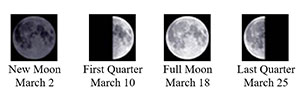The Ongoing Search for Far-Off Planets in Our Skies
Opinion Advocates for ideas and draws conclusions based on the author/producer’s interpretation of facts and data.
 By Scott Levine
By Scott Levine
Last December, NASA and the Jet Propulsion Laboratory (NASA/JPL) launched the James Webb Space Telescope (JWST). Many people see Webb as the much-more-powerful successor to NASA/JPL’s Hubble Space Telescope.
For more than 30 years, Hubble has driven our understanding of the universe and given us an endless supply of desktop background photos. It’s incredible to think what we might learn once the JWST is fully up and running.
One of the JWST team’s goals is to expand the ongoing hunt for exoplanets, planets that orbit stars other than our sun. Astronomers have always imagined planets at other stars, but first identified possible exoplanets in 1988. In 1992, they confirmed the first. According to Extrasolar Planets Encyclopaedia, there are now close to 5,000 confirmed planets at other stars, some near, some far, some in multi-planet systems.
Most of these planets’ host stars are too faint or distant for us to see without specialized equipment, and seeing the exoplanets themselves is simply out of the question. They’re just too small and their parents’ starlight is too bright and washes them out.
That doesn’t mean we can’t explore a little on our own. Two naked-eye stars that astronomers believe have exoplanets are easy for us to see in the evenings this month.
First, let’s find our old friend Orion. He’s in the southern part of the sky in the evenings. Let’s draw a line through his three belt stars and toward the west. That’s, generally, toward the right. The bright red star we’ll come to along that line is Aldebaran, the brightest in Taurus, the bull. It’s about 65 light years away. There’s some doubt, but astronomers believe there is a star about five times the size of Jupiter orbiting Aldebaran at about 1.5 times the distance earth orbits the sun.
Next, let’s draw a line from Rigel, at Orion’s right foot, through Betelgeuse at his left shoulder. Continuing that line, we’ll come to Castor and Pollux, which represent Gemini, the mythological twins. Pollux, about 35 light years away, is the brighter of the pair.
In 2006, the astronomer Artie Hatzes confirmed the existence of a planet about twice the size of Jupiter there. It’s since been named Thestias, for Pollux’s son. Like Aldebaran’s planet, Thestias also orbits Pollux at about 1.5 times the distance we travel around the sun.

We can’t see these planets from our neighborhoods, but at times like these it’s always fun to try to imagine the scene as though we could; as though we’re closer to it. To help us out a bit, the moon slides past Aldebaran on Mar. 8 and Mar. 9. Then a few days later, it teams up with Pollux on Mar. 12-13.
Imagine seeing the moon drifting across the sky above us. As it does, our gaze stretches off into the galaxy, where we’ll see planets orbiting these stars, as well as countless others.
Our lives, and the vastness of the galaxy can be overwhelming. It’s hard to know what we’re looking at sometimes. I find great comfort, though, in looking up on a clear night and wondering who’s looking back with their space telescopes. Maybe they’re wondering who’s out there, too.
I hope you’ll take a look, and wave, too, this month.
Scott Levine (astroscott@yahoo.com) is an astronomy writer and speaker from Croton-on-Hudson. He is also a member of the Westchester Amateur Astronomers, who are dedicated to astronomy outreach in our area. For information about the club including membership, newsletters, upcoming meetings and lectures at Pace University and star parties at Ward Pound Ridge Reservation, visit westchesterastronomers.org.

Examiner Media – Keeping you informed with professionally-reported local news, features, and sports coverage.

